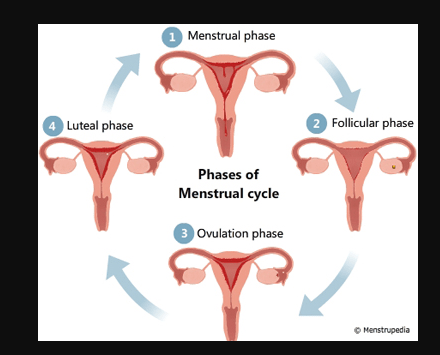
Best Stages of the Menstrual Cycle ;-A woman’s body undergoes a variety of changes each month in the years leading up to menopause in order to prepare for a potential pregnancy. The menstrual cycle is the name given to this string of hormonally induced events.
An egg develops and is discharged from the ovaries once per menstrual cycle. The uterus’ lining thickens throughout time. The uterine lining sheds during a menstrual cycle if there is no pregnancy. Then the cycle resumes.
The four stages of a woman’s menstrual cycle are as follows:
hormonal stage
the follicular stage
ovulatory stage
luteal phase
Each phase’s duration can vary from woman to woman and over the course of time.

Top 4 Best Stages of the Menstrual Cycle
Menstrual phase
The first phase of the menstrual cycle is known as the menstrual phase. You also receive your menstruation at that time.
When an egg from the previous cycle is not fertilized, this phase begins. Estrogen and progesterone levels fall since pregnancy has not yet occurred.
Your uterus’ thicker lining, which would normally support a pregnancy, no longer serves a purpose and sheds via your vagina. Blood, mucus, and tissue are all expelled from the uterus during your period.Top 4 Best Stages of the Menstrual Cycle
These signs of a period could be present in you:
- cramps (try these home remedies)
- tender breasts
- bloating
- mood swings
- irritability
- headaches
- tiredness
- low back pain
Women often spend 3 to 7 days during the menstrual phase of their cycle. Some women’s periods are longer than others.
Also See;Why Implantation Bleeding Problem Increasing 2022?
Follicular phase
The follicular phase begins on the first day of your period and ends when you ovulate (there is some overlap with the menstrual phase).
Follicle-stimulating hormone is first released by your pituitary gland in response to a signal from your hypothalamus (FSH). Your ovaries are stimulated by this hormone to create 5 to 20 little sacs known as follicles. Undeveloped eggs are found inside each follicle.
Only the healthiest egg will finally mature. The remaining follicles will be reabsorbed into your body. (On rare circumstances, a lady may have two mature eggs.)
A rise in estrogen caused by the growing follicle thickens the lining of your uterus. An embryo can grow in a nutrient-rich environment as a result.
The usual follicular phase lasts roughly three months.Top 4 Best Stages of the Menstrual Cycle
Ovulation phase
During the follicular phase, increasing estrogen levels cause your pituitary gland to release luteinizing hormone (LH). This is what triggers the ovulation process.
Your ovary produces a mature egg during ovulation. The fallopian tube directs the egg toward the uterus, where the sperm will fertilize it.
You can only become pregnant during the ovulation phase of your menstrual cycle. If you experience any of the following symptoms, you may be ovulating:
a little increase in body temperature during rest
a more substantial, egg-white-textured discharge
If you have a 28-day cycle, ovulation takes place around day 14 — smack in the middle of your menstrual cycle. It is roughly 24 hours long. The egg will expire or disintegrate after a day if.Top 4 Best Stages of the Menstrual Cycle
Luteal phase
The follicle transforms into the corpus luteum after releasing its egg. Progesterone and possibly estrogen are the major hormones released by this structure. The increase in hormones keeps your uterine lining thick and prepared for the implantation of a fertilized egg.
Your body will generate human chorionic gonadotropin if you become pregnant (hCG). The hormone that pregnancy tests look for is this. It keeps the uterine lining thick and aids in maintaining the corpus luteum.
The corpus luteum will shrink and resorb if you are not able to conceive. This results in lower estrogen and progesterone levels, which trigger the start of your menstruation. Throughout your period, the uterine lining will shed.
If you don’t become pregnant during this phase, you can encounter premenstrual syndrome symptoms (PMS). These consist of:
- bloating
- breast swelling, pain, or tenderness
- mood changes
- headache
- weight gain
- changes in sexual desire
- food cravings
- trouble sleeping.Top 4 Best Stages of the Menstrual Cycle
Frequently Asked Questions
- What changes occur during menstrual cycle?
Twice throughout the menstrual cycle, estrogen levels increase and decrease. The mid-follicular phase sees an increase in estrogen levels, which fall sharply after ovulation. The mid-luteal phase is then followed by a subsequent increase in estrogen levels, which is followed by a reduction towards the end of the menstrual cycle.
- What part of the menstrual cycle do you feel the best?
Compared to most other menstrual cycle phases, the follicular phase is when most women feel the most energizing and content. The luteinizing hormone begins to stimulate ovulation at this time. This also boosts the sex drive in women, according to certain research. also a greater tolerance for discomfort.
- What are the changes that occur during menstrual cycle Class 10?
In the middle of the cycle, the levels of LH and FSH peak. Ovulation is induced by LH. Just prior to ovulation, LH levels suddenly increase. The burst follicle matures into the corpus luteum after ovulation, which secretes progesterone. As a result, progesterone levels rise during the luteal phase.
Be the first to comment